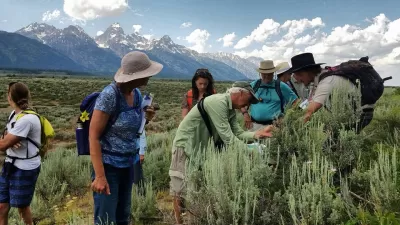A few examples from around the world illustrate the power of crowdsourcing to expand the scope of scientific inquiry.

For some projects, data collection is too difficult for one team of scientists. Sometimes data are spread across the country. Other times, data need updated yearly. In cases like these, volunteers are critical.
Citizen science projects recruit volunteers to collect data and answer real-world questions—like the effects of light pollution on the night sky, or climate change on plant growth. This information is vital to scientists, revealing remarkable insights. These projects are also an excellent way for non-scientists to get involved in the field.
Read on to discover six citizen science use cases at work.
1. The Christmas Bird Count
The Christmas Bird Count is an annual census of birds organized by the Audubon Society and conducted by volunteer birders around the United States. Data from the count revealed climate change is causing a reduction in the population [pdf] of birds. Since 2009, they've released a number of surveys and studies that investigate and illustrate how global warming is disrupting the environment.
The Audubon Society has conducted the survey for more than 115 years, making it the longest-running citizen science project in the world. Their data provides a framework for other projects, including how to use, organize, and clean information gathered by a large number of volunteers.
2. Globe at Night
The Globe at Night database measures the real-world impact of light pollution. Citizen scientists calculate the brightness of the sky where they live, allowing experts to understand the effect of pollutants on nighttime visibility.
Data from the project is most useful to astronomers. However, scientists from other fields benefit, too. Environmental scientists studying the behavior and migration patterns of bats used the Globe at Night data to investigate if and how light pollution affects the animal's behavior.
3. Stardust@home
In 2006, a small capsule from NASA's Stardust spacecraft returned to Earth after collecting tiny particles of dust from stars. Scientists initially estimated the mission would gather around 45 interstellar dust particles. After a search of one-third of the collector, however, the team only found four. These particles are tiny, about a micron—a millionth of a meter—in size, and challenging to locate.
Due to the small view of the microscope, scientists would need to move it around 1.6 million times to search the entire collector. Instead, they're reaching out to online volunteers for help. When two volunteers identify a particle on the same image, it alerts a scientist, who reviews their findings.
4. World Water Monitoring Day
Water quality data can be challenging to collect, primarily due to the sheer size. Plus, quality can vary significantly from location to location. On World Water Monitoring Day, volunteers use a pre-built testing kit to collect local data on four markers of water quality—temperature, turbidity, dissolved oxygen levels and acidity.
Scientists use this information to develop a better sense of local water quality and inform research on ecological and public health. The data can also help scientists understand how major changes to an environment—like Hurricane Harvey in 2017—alter water quality, and how long it takes for an environment to return to normal after a catastrophic event.
5. Project BudBurst
Scientists know that climate change is altering how plants grow, including when they bloom. This change could have serious implications for agriculture and the health of native ecosystems. Yet without proper data, it's impossible to understand the full extent of those effects.
Volunteers with Project BudBurst monitor plants to observe the timing of their phenophases—the different life cycles plants go through. This data helps scientists understand how increased temperatures, along with other environmental changes, might shape agriculture and native ecosystems. In the future, this data could help us understand and predict the effects of climate change on plant life.
6. The Appalachian Mountain Club's View Guides
The relationships between pollution, respiratory health, and exercise aren't fully understood. While air quality data helps scientists understand how pollutants affect breathing, a limited pool of data means they don't have the full picture. Those dedicated to preserving the Earth can volunteer to help.
Appalachian Mountain Club's view guides are volunteer hikers who measure visibility from trails. Combined with local health information, scientists use the visibility data collected to better understand the relationship between haze, pollution, and the effectiveness of exercise. The Club also publishes reports on the visibility of specific hikes, allowing people to plan their trips in and through Appalachia.
How Citizen Science Helps Scientists
Actionable science requires heaps of data, which can be tedious or impossible for a small team to collect. Luckily, citizen science can fill in those gaps.
Volunteers have made significant strides in the scientific community. They pinpoint the effects of climate change on bird populations and plant blooms. They scan through massive volumes of interstellar matter. They also head outdoors, collecting water samples and reporting on air quality.

Trump Administration Could Effectively End Housing Voucher Program
Federal officials are eyeing major cuts to the Section 8 program that helps millions of low-income households pay rent.

Planetizen Federal Action Tracker
A weekly monitor of how Trump’s orders and actions are impacting planners and planning in America.

The 120 Year Old Tiny Home Villages That Sheltered San Francisco’s Earthquake Refugees
More than a century ago, San Francisco mobilized to house thousands of residents displaced by the 1906 earthquake. Could their strategy offer a model for the present?

Alabama School Forestry Initiative Brings Trees to Schoolyards
Trees can improve physical and mental health for students and commnity members.

NYC Outdoor Dining Could Get a Re-Do
The city council is considering making the al fresco dining program year-round to address cost concerns from small businesses.

HSR Reaches Key Settlement in Northern California City
The state’s high-speed rail authority reached an agreement with Millbrae, a key city on the train’s proposed route to San Francisco.
Urban Design for Planners 1: Software Tools
This six-course series explores essential urban design concepts using open source software and equips planners with the tools they need to participate fully in the urban design process.
Planning for Universal Design
Learn the tools for implementing Universal Design in planning regulations.
Ada County Highway District
Clanton & Associates, Inc.
Jessamine County Fiscal Court
Institute for Housing and Urban Development Studies (IHS)
City of Grandview
Harvard GSD Executive Education
Toledo-Lucas County Plan Commissions
Salt Lake City
NYU Wagner Graduate School of Public Service






























